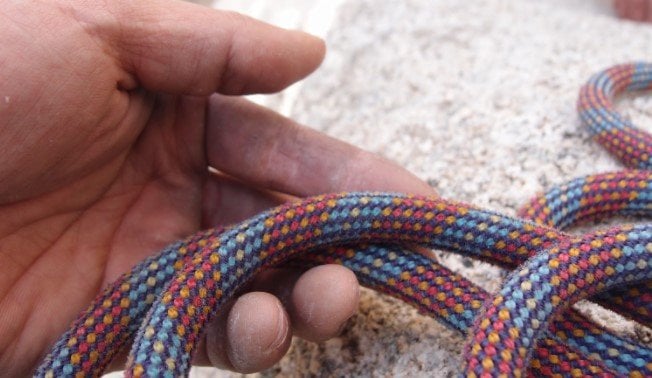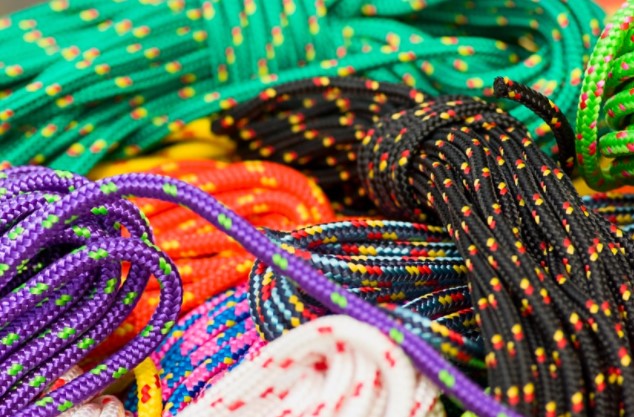If you ever intend on climbing outdoors or leading routes inside a gym, you will need to have your own climbing rope. This guide will help you make the best decision for your upcoming rope purchase. Additionally, some of the most common questions about climbing ropes have also been detailed below.
Length of Rope
When you climb, you need a rope that can allow the climber to reach the top of the anchor and descend down. This means your rope needs to be at least double the length of the route. You will still want a minimum 1 meter/3 feet of rope in order to tie your safety knot at the end.
In the industry, there are three average sizes for a rock climbing rope:
- 60 meter / 197 feet
- 70 meter / 230 feet
- 80 meter / 262 feet
There are gym climbing ropes that are only 30 to 40 meters (98 to 131 feet), which can also be purchased. For climbers who are leading indoors, these ropes are best because there is not so much excess rope that must be flaked to get started.
If you know that you regularly climb 30 meter / 100 foot routes, a 70 meter rope will be the best one for you. Since you need 200 feet of rope you climb a 100 foot you, you will have 30 feet of slack available.
Should you only climb 28 meter / 95 foot routes or smaller, you can make do with a 60 meter rope. It will be lighter to carry, which is always a bonus when you are approaching and leaving the crag.
An 80 meter rope is useful for trad climbers who know there are large distances between each pitch. However, a climber that is new to climbing outdoors will likely not need all of the additional length or weight to enjoy their day at the crag.
Thickness Of Rope
Rock climbing ropes come in a few different thickness sizes. In order to choose the best one, you need to know what delay device you are using. While most belay devices can handle thicker ropes, you want your rope to smoothly move through the device.

Thicker climbing ropes come in sizes of 9.8 mm 10.5 mm, and thinner climbing ropes range from 9 mm to 9.5 mm. If your belay device can handle both thick and thin ropes, then you need to consider what is most important to you.
A thinner climbing rope is lightweight, which is beneficial for multi-pitch climbers. However, they do slide through the device more freely. These ropes require extra attention in order to keep your partner safe.
On the other handle, a thicker rope is more durable and tends to last longer. These ropes do create more rope drag between the points of protection. Climbers must be mindful of this during their climb.
What Is The Difference Between Static & Dynamic?
A static rope does not have any give when you use it. This means you can pull on it from either end and it will not move.
On the other hand, a dynamic rope can stretch out a bit. Think of a bungee cord and how it stretches and then retracts.
When you are doing any lead climbing (meaning you are not protected from a rope above), you need to climb with a dynamic rope. This ensures the rope absorbs the shock when you fall, not your spine.
A static rope can be useful in certain situations. If you are building a top rope route from above,a static rope is a good option. This rope can also be used to create a trad anchor from a tree.
What Makes A Rope High-Quality?
A high-quality climbing rope will smoothly slide through your belay device. This is crucial when your partner is climbing. You do not want to short line them because of a snag in the belay device.
Additionally, higher quality climbing ropes tend to look better. The colors and perfectly capped ends tend to signify that the manufacturer took their time creating the rope. The ends are less likely to fray and the rope will still remain nice to look at for years to come.
How Long Does A Rock Climbing Rope Last?
How long your rock climbing rope lasts will depend on how often you use it and how well you treat it. In a perfect world, the rope will last about 5 to 10 years. However, the rocks and features will likely cause small damage over time.

Each time you climb, you need to flake your rope. While you are flaking, you need to examine the rope and see if there are tears or frays in it. If there are, it’s time to consider getting a new rope.
Incredibly active climbers may only have their rope last a few years while others can have a healthy rope for a decade. Manufacturers recommend replacing the rope after 10 years for your safety. Even if there are no visible signs of damage, the interior of the rope likely has some damage after a decade of use and storage.
Takeaways
Several manufacturers have created climbing ropes over the years. Some climbers will only climb with a particular brand while others are simply looking for the cheapest on the market.
Ultimately, the best climbing rope for you will be long enough to safely climb a route and be the appropriate thickness for your delay device. Ideally, you will opt for a dynamic rope over a statistic rope when you are lead climbing.
